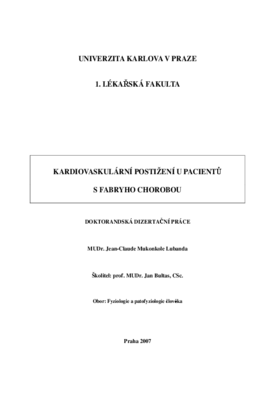Kardiovaskulární postižení u pacientů s Fabryho chorobou
Cardiovascular involvement in patients with Fabry disease
dizertační práce (OBHÁJENO)

Zobrazit/
Trvalý odkaz
http://hdl.handle.net/20.500.11956/12859Identifikátory
SIS: 133246
Kolekce
- Kvalifikační práce [4509]
Vedoucí práce
Oponent práce
Kittnar, Otomar
Ošťádal, Bohuslav
Fakulta / součást
1. lékařská fakulta
Obor
-
Katedra / ústav / klinika
3. lékařská fakulta UK
Datum obhajoby
27. 9. 2007
Nakladatel
Univerzita Karlova, 1. lékařská fakultaJazyk
Čeština
Známka
Prospěl/a
Vedle některých nových poznatků, zlepšujících naše porozumění patofyziologii kardiálního postižení u pacientů s Fabryho nemocí (tzv. gnoseologický přínos), mají naše výsledky důležitý praktický význam. Centrálním poznatkem je, že hypertrofie levé komory u nemocných s FN má komplexní etiopatogenezi a rozdílný výskyt u mužů a žen jeho detekci je vhodnější echokardiografické vyšetření. Pro detekci hypertrofie LK u pacientů s FN pomocí EKG je vhodné použít jiné citlivější indexy hypertrofie levé komory a aplikovat nižší hranice oproti standardní populaci. Posouzení strukturálních změn levé komory srdeční má u nemocných s FN důležitý prognostický význam a může ovlivnit naši léčebnou strategii. Enzymatická substituční terapie má vliv na strukturu a funkci levé komory. Při přirozeném průběhu onemocnění neléčení pacienti umírají v poměrně mladším věku a jejich léčba je velice náročná. Snaha aktivně vyhledávat nové pacienty a provést diagnózu v časném stadiu s cílem časného zahájení specifické léčby před rozvojem terminálního orgánového poškození je velmi naléhává. V budoucnu bude žádoucí provedení velké randomizované multicentrické studie s enzymatickou substituční terapií zaměřené na posouzení kardiálního postižení. Nicméně vliv tradiční farmakoterapie (tj. pomocí ACE-I, ARB atd.) na hypertrofii levé komory u...
Fabry disease (FD) is an X-linked genetic disorder of glycosphingolipid metabolism due to deficiency of lysosomal enzyme a-galactosidase A. The disease is characterized by the progressive intracellular accumulation of neutral glycosphingolipids throughout the body, including the cardiovascular system. Myocardial abnormalities are characterized mainly by parietal thickening, the most frequent abnormal structural pattern being concentric left ventricular (LV) hypertrophy. In some patients the disease mimics a typical hypertrophic obstructive cardiomyopathy. It has been reported that in some patients the cardiac involvement could be a sole manifestation of the disease. Systolic function is largely preserved in most affected individuals. In contrast, mild to moderate diastolic filling impairment is a relatively common finding. Valvular structural abnormalities are frequent due to valvular infiltration. Valvular regurgitation seems to be relatively frequent but mostly nonsignificant. Electrocardiographic changes in Fabry disease are multiple and include AV conduction abnormalities (PQ interval shortening or AV blockades), signs of LV hypertrophy and repolarization abnormalities. Cardiac symptoms in Fabry disease patients include shortness of breath on effort, vasospastic and/or exertional angina pectoris,...
